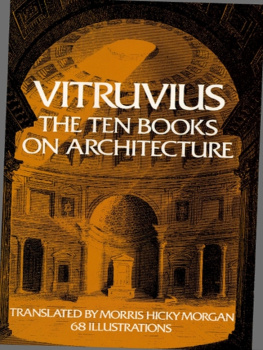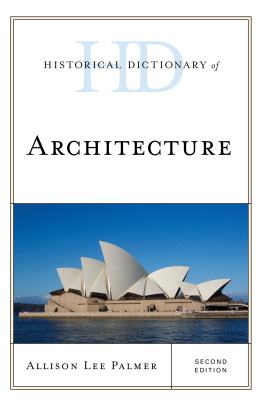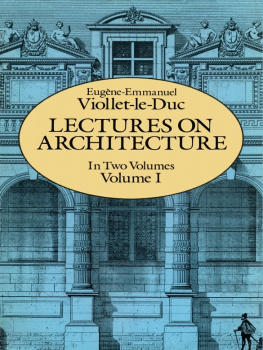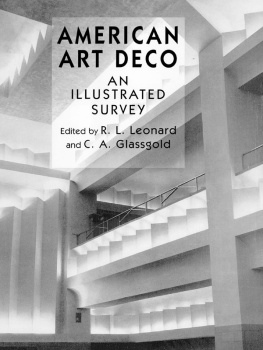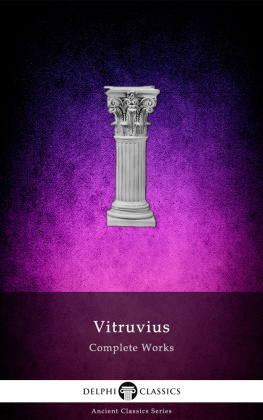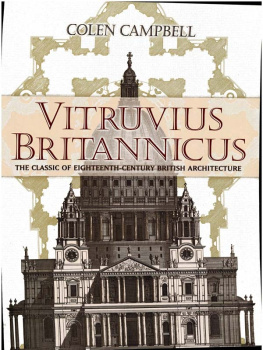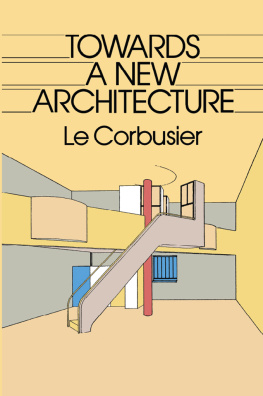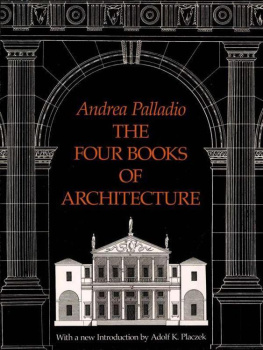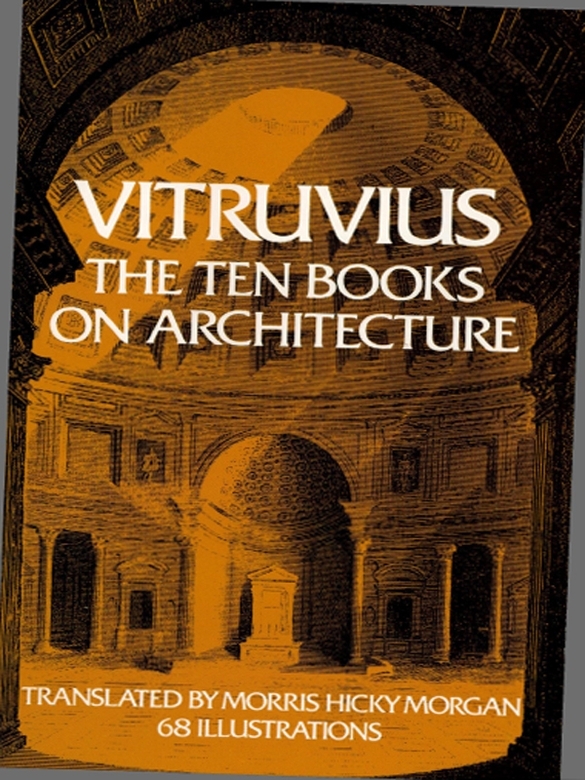SCAMILLI IMPARES (BOOK m, ch. 4)
No passage in Vitruvius has given rise to so much discussion or been the subject of such various interpretations as this phrase. The most reasonable explanation of its meaning seems to be that of mile Burnouf, at one time Director of the French School at Athens, published in the Revue Gnrale del Architecture for 1875,as a note to a brief article of his on the explanation of the curves of Greek Doric buildings. This explanation was accepted by Professor Morgan who called my attention to it in a note dated December 12, 1905. It has also quite recently been adopted by Professor Goodyear in his interesting book on Greek Refinements.
Burnouf would translate it nivelettee ingales, unequal levellers. He states that in many parts of France in setting a long course of cut stone the masons make use of a simple device consisting of three pointed blocks of equal height used as levellers, of which two are placed one at each extremity of the course, while the third is used to level the stones, as they are successively set in place, by setting it upon the stone to be set and sighting across the other two levellers. If two levellers of equal height are used with a third of less height placed at the centre of the course, with perhaps others of intermediate height used at intermediate points, it would obviously be equally easy to set out a curved course, as, for instance, the curved stylobate of the Parthenon which rises about three inches in its length of one hundred feet. By a simple calculation any desired curve could be laid out in this way. The word scamillus is a diminutive of scamnum, a mounting-block or bench.
Practically the same explanation is given by G. Georges in a memoir submitted to the Sorbonne in April, 1875. Georges adds an interesting list, by no means complete, of the various explanations that have been offered at different times.
| Philander (1522-1552). | Projections of the stylobate or pedestals. |
| Barbaro (15561690). | The same. |
| Bertano (1558). | Swellings of the die of the stylobate or bosses in the stylobate or the frieze of the entablature. |
| Baldus (1612). | Sub-plinths placed under the bases of the columns. |
| Perrault (16731684). | Projection of the stylobate. |
| Polleni (1739). | The same. |
| Galiani (1758-1790). | Projection of the stylobate with hypothesis of embossments on the stylobates and the bases of the columns. |
| Tardieu and Coussin (1837) and Mauffras (1847). | Projection of the stylobates. |
| Aurs (1865). | Steps or offsets between the stylobate and the columns. |
The list of Georges is wholly French and Italian.
Fra Giocondos interpretation is indicated in our reproduction of the illustration in his edition of 1511.
Hoffer (1838) and afterwards Pennethorne (1846) and Penrose (1851) gave measurements showing the curvatures in the Parthenon and the temple of Theseus in Athens. Penrose and most writers who followed him supposed the scamilli impares to be projections or offsets on the stylobate required on account of the curves to bring the column into relation with the architraves above, and similar offsets of unequal or sloping form were supposed to be required above the abaci of the capitals, but such offsets, although sometimes existing, have no obvious connection with the passage in Vitruvius. C. Btticher (1863) and more recently Durm have denied the original intention of the curves and ascribe them to settlement, a supposition which hardly accords with the observed facts. Reber, in the note on this passage in his translation of Vitruvius (1865), thinks the scamilli were sloping offsets on the stylobate to cause the inclination of the columns, but admits that nothing of the kind has been found in the remains so far examined. It may be added that this is at variance with the statement of the purpose of the scamilli which Vitruvius gives.
Assuming, as I think we must, that the horizontal curvature of the stylobate in such buildings as the Parthenon was intended and carefully planned, Burnoufs explanation fits the case precisely and makes this passage of Vitruvius straightforward and simple. This can be said of no other explanation, for all the others leave the passage obscure and more or less nonsensical. Durms attempt to refer the passage to the case of the temple with a podium which has Just been spoken of by Vitruvius is somewhat forced, or at least unnecessary. Clearly the passage refers to stylobates in general; but Reber also so translates and punctuates as to make the use of the acamilli impares refer only to the case of temples built in the Roman manner with the podium. His resulting explanation still leaves the passage obscure and unsatisfactory. One may finally refer to the ingenious but improbable explanation of Choisy, who translates it echelons impairs, and explains them as offsets arranged accord-mg to the odd numbers, nombres impairs, i.e., offsets varying at equal intervals in the proportion of 1,3, 5, 7, 9, etc., and which he claims was applied also to the entasis of columns.
H. L. WARREN.
A CATALOG OF SELECTED
DOVER BOOKS
IN ALL FIELDS OF INTEREST
A CATALOG OF SELECTED DOVER BOOKS IN ALL FIELDS OF INTEREST
CONCERNING THE SPIRITUAL IN ART, Wassily Kandinsky. Pioneering work by father of abstract art. Thoughts on color theory, nature of art. Analysis of earlier masters. 12 illustrations. 80pp. of text. 5 x 8.
0-486-23411-8
CELTIC ART: The Methods of Construction, George Bain. Simple geometric techniques for making Celtic interlacements, spirals, Kells-type initials, animals, humans, etc. Over 500 illustrations. 160pp. 9 x 12. (Available in U.S. only.)
0-486-22923-8
AN ATLAS OF ANATOMY FOR ARTISTS, Fritz Schider. Most thorough reference work on art anatomy in the world. Hundreds of illustrations, including selections from works by Vesalius, Leonardo, Goya, Ingres, Michelangelo, others. 593 illustrations. 192pp. 7 x 10
0-486-20241-0
CELTIC HAND STROKE-BY-STROKE (Irish Half-Uncial from The Book of Kells): An Arthur Baker Calligraphy Manual, Arthur Baker. Complete guide to creating each letter of the alphabet in distinctive Celtic manner. Covers hand position, strokes, pens, inks, paper, more. Illustrated. 48pp. 8 x 11.
0-486-24336-2
EASY ORIGAMI, John Montroll. Charming collection of 32 projects (hat, cup, pelican, piano, swan, many more) specially designed for the novice origami hobbyist. Clearly illustrated easy-to-follow instructions insure that even beginning papercraft-ers will achieve successful results. 48pp. 8 x 11.
0-486-27298-2
BLOOMINGDALES ILLUSTRATED 1886 CATALOG: Fashions, Dry Goods and Housewares, Bloomingdale Brothers. Famed merchants extremely rare catalog depicting about 1,700 products: clothing, housewares, firearms, dry goods, jewelry, more. Invaluable for dating, identifying vintage items. Also, copyright-free graphics for artists, designers. Co-published with Henry Ford Museum & Greenfield Village. 160pp. 8 x 11.
0-486-25780-0
THE ART OF WORLDLY WISDOM, Baltasar Gracian. Think with the few and speak with the many, Friends are a second existence, and Be able to forget are among this 1637 volumes 300 pithy maxims. A perfect source of mental and spiritual refreshment, it can be opened at random and appreciated either in brief or at length. 128pp. 5 x 8.

